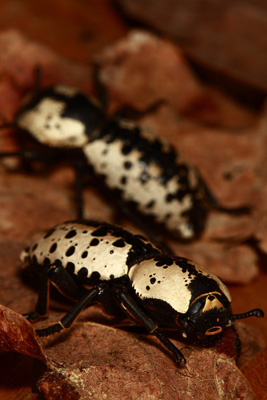
 |
| Home ¦ Ironclads ¦ Key to Genera & Species ¦ Fact Sheets ¦ Gallery ¦ Morphological Atlas ¦ Glossary ¦ References ¦ About |
BiologyIronclad and Cylindrical Bark Beetles are usually found under bark of dead or dying trees or in the surrounding litter. Some members are strictly found on conifers, others on hardwoods, and a number on both. Many of these beetles are cylindrical in shape and are frequently found in the holes or passages bored by other insects. Members of the Zopheridae are thought to include both economically harmful and beneficial insects.Risk Several zopherid groups may also be destructive, with members frequently associated with particular fungi known to harm or kill valuable hardwood trees. It is speculated that these beetles may play a critical role in the spread of these fungal diseases. Colobicus parilus is frequently found on stored roots and fruits and is suspected to transmit Diplodia (Coelomycetes) to yams, sweet potatoes, cassava and citrus. This species is imported in commercial shipments of stored goods (Hinton, 1945). Phloeodalis reitteri has been recorded as the carrier of Fusarium moniliforme var. subglutinans, the fungal species causing pineapple gum disease. It has been shown that pineapple crop losses are unusually high when large numbers of the beetle are present, and, when artificially infested with adults, fruits in the flowerings stage rotted in 100% of cases. Several genera (Bitoma, Synchita, Microsicus, Paha) are frequently found on dead or dying trees associated with Hypoxylon, a fungus that kills many valuable hardwood trees throughout the US. It is possible these beetles play a role in the introduction or transportation of the fungus, although this needs further examination (Stephan, 1989). The larvae of several other zopherid groups (Usechini, Phellopsis) bore into soft wood in search of fungus. The genera Phloeodes and Zopherus (Zopherini) also have anatomical modifications as both larvae and adults that suggest the ability to bore into sound wood, many having been collected on or under the bark or roots of Populus, Morus, Cayra, Pinus, Juniperus, and Quercus. These beetles may pose a potential hazard to lumber products. Due to the subcortical, saprophagous/mycophagous nature of these beetles, it is very possible the introduction and subsequent establishment of foreign taxa will be a common occurrence. Beneficial Several genera (Colydium, Aulonium, Nematidium, Lasconotus) are frequently encountered in the bored tunnels of platypodine and scolytine ambrosia beetles (Scolytus, Ips, Dendroctonus spp.). These genera (and no doubt numerous others) are thought to be predaceous as both larvae and adults on these destructive beetle pests, serving as potential biological control agents (Ivie, 2002a; Ślipiński and Lawrence, 2010; Stephan, 1989). |
 Zopherus nodulosus haldemani © N.P. Lord |
|||
 © 2011-2015 Lord, N.P., Nearns, E.H., and K.B. Miller |
||||